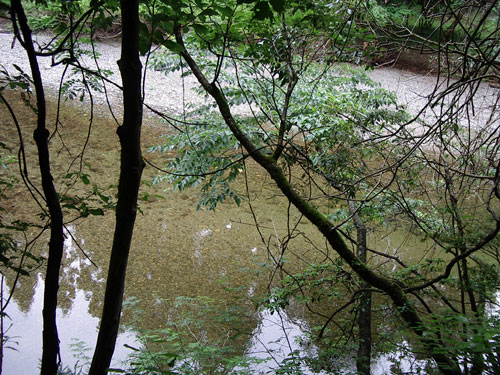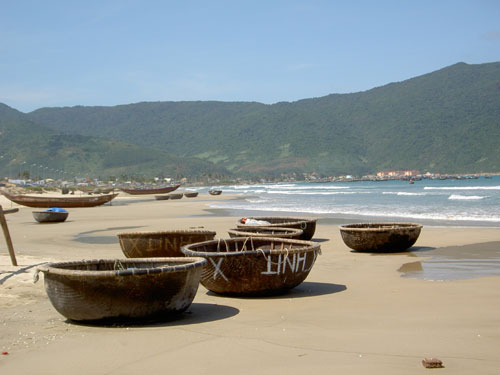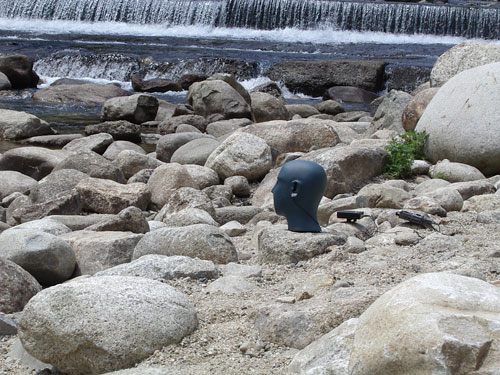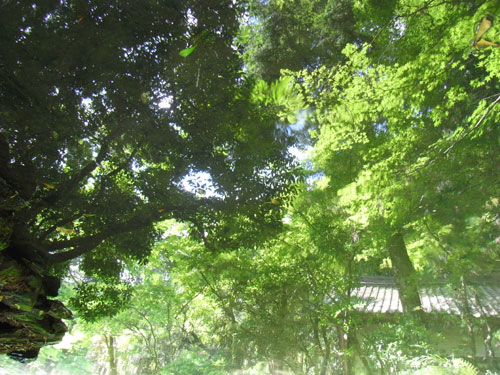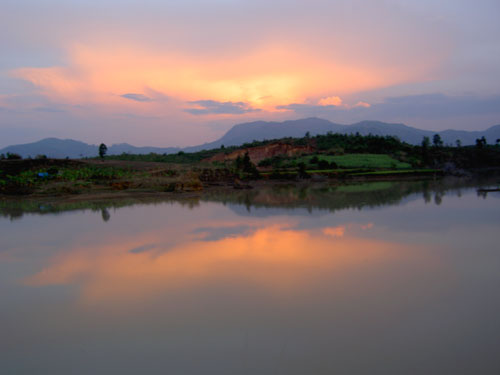
Scenery of Water | Eisuke Yanagisawa
Gr 060 | Gruen CD-R > [Sold Out]
MP3 & FLAC > [order]
Field Recordings from Vietnam, Myanmar and Japan.
We can’t listen to the water itself. We can only hear the impact of water on something. When I listen to the sounds of shallow stream for a while, suddenly I feel as if I was caught in the water and listening them from inside of the water. When I listen to the sounds of water dripping in quiet situation, my ears enjoy listening to the rhythmic patterns of its occurrence and fading into the back ground. The sounds of water make random rhythm, delicate melody and subtle overtones which vary depending on the physical contact surface, room reverberation, spatial size and so on. In other words, the sounds of water reflect the character of the space. And the space emerges through the sounds. In that sense, we may listen to the scenery through the water rather than listen to the water in the scenery.
01 Bathroom
The water dripping sounds from broken water pipe in the hotel bathroom.
Recorded on April 2006, Kontum, Vietnam.
02 Cicada and Stream
In a summer day, cicada was calling in the Matsuo Grand Shrine.
Recorded on June 2007, Kyoto, Japan.
03 Frogs in a Shrine
Many frogs were calling repeatedly in a Fushimi Inari shrine. High school students were playing baseball far away.
Recorded on May 2005, Kyoto, Japan.
04 Hanoi Rain
In August, monsoon rains arrive in Hanoi. I put microphones close to the window of my room.
Recorded on August 2006, Hanoi, Vietnam.
05 Hallow Pole on the Beach
I heard a resonant sound coming from an old hallow pole on a beach.
Recorded on September 2007, Kehi no Matsubara, Japan.
06 Kyauktan
Kyauktan is a small town famous for its pagodas (temples) stood on the small island in the middle of the Yangon River. I was sitting at the wharf watching the locals coming across the river for worship.
Recorded on December 2004, Kyauktan, Myanmar.
07 Rainy Morning
This is an ordinary rainy morning recorded just outside of my apartment room.
Recorded on June 2007, Kyoto, Japan.
08 Shishiodoshi
You can listen to the sounds of “Souzu”, a kind of “Shishiodoshi”, on the left.
Recorded on August 2007, in the garden of Shisendo temple, Kyoto, Japan.
en.wikipedia.org/wiki/Shishi_odoshi
09 Sagaing Hill
Sagaing lies 21km south-west of Mandalay, Myanmar. I was half way to the top of the hill. I heard a sutra read by woman from speaker. Some children passed me by.
Recorded on December 2004, Sagaing, Myanmar.
10 Uguisu
Uguisu(bush warbler) sings in the Honenin temple.
Recorded on July 2007, Kyoto, Japan.
11 Under the Stream
I put hydrophone into a shallow stream in Kamikatsura forest.
Recorded on August 2007, Kyoto, Japan.
11 Tracks (34′19″) | Headphone listening is recommended.
(c) by Eisuke Yanagisawa
Web: otonoha.x0.com
Field Recording Series by Gruenrekorder
Gruenrekorder / Germany / 2009 / Gr 060 / LC 09488
Frans de Waard | VITAL WEEKLY
Germany’s Gruenrekorder is a label which releases all kinds of experimental sound art, but field recordings have the main interest. In some cases, such as here in ‚Scenery Of Water‘, it deals with pure and unprocessed sounds. Eisuke Yanagisawa hails from Kyoto, and works as a field recordist since 2004. On this CD he has eleven pieces from Vietnam, Myanmar and Japan. Somehow ‚water‘ runs as a theme through all of these pieces. What is there to say about these recordings? Not much, I guess. There seems to an absence of any human activity. Just outdoor sounds (well, and indoor, such as in ‚Bathroom‘), and they are recorded well, if not a bit soft, volume wise. It works well with headphones. Nice enough, perhaps most engaging to those which places has visited. And where as six pieces have been recorded in Kyoto – the only place I have visited of the various locations here – I can’t say I ‚recognize‘ anything. Might not be the necessary anyway. I guess for those who love Chris Watson and want to seek out more alike.
Jez riley French | ‚IN PLACE‘
Over the course of these 11 short tracks we are simply presented with a selection of recordings made by the artist that feature water in various ways. We hear dripping taps, rivers, waves & rain. Only tracks 6 & 9 appear to have other elements that dominate the recordings.
It’s a hard cd to review to be honest. For the most part I’m left wnating to hear longer takes of just a few of the tracks & I can only assume that this is all that was recorded at the time. If you can get past that then you’ll be ok listening to this disc. The tracks featuring rain are the most interesting for me as they do capture a sense of place – the humidity and the wet, bright green and mud coloured landscape comes into ones mind. That & the open doors of houses and buildings in countries where sweat and rain are constants.
As with several of Gruenrekorders field recording series cd’s we are presented with work by artists who are failry new to field recording. At thier best that sense of early excitement and exploration comes across and in this release I think we can hear someone taking some steps forward, but it needs to be said that these are very simple recordings made with very simple equipment. There are no hydrophone recordings – these are all made with normal ambient mics.
It will be interesting to hear what he does next.
Tobias Fischer | tokafi
Eisuke Yanagisawa: „Water in borrowed landscapes“
We take so much for granted. The sound of water, for example. We speak of it with a kind of nonchalance as though we knew exactly what it were. But is it ever the same? And does it actually exist at all? On „Scenery of Water“, Eisuke Yanagisawa has embarked on a journey to explore these questions and has returned with a few remarkable answers – some of them trivial but nonetheless inspiring, others unexpected but nonetheless entirely logical. „We can’t listen to water itself. We can only hear the impact of water on something“, Yanagisawa writes in his introduction to „Scenery of Water“, „When I listen to the sounds of a shallow stream for a while, I suddenly feel as if I were caught in the water and hearing them from inside of the water. When I listen to the sounds of water dripping in a quiet situation, my ears enjoy listening to the rhythmic patterns of its occurrence and to them fading into the back ground.“ Accordingly, he has compiled an eclectic and agreeably unpredictable set of field recording scenes, most of them short and sweet to exemplify a point of view rather than allowing the listener to immerse himself in the aural action: Included are „water dripping from a broken water pipe in the hotel bathroom“, „monsoon rains arriving in Hanoi“ and „a shallow stream in the Kamikatsura forest“. We caught up with Eisuke Yanagisawa during his preparations for his second album on the Frankfurt-based Gruenrekorder imprint. In the meantime, „Scenery of Water“ has already sold out from the label – but even the sound bytes on the Gruenrekorder-site are making for an exciting proposition.
There are some very interesting thoughts behind „Scenery of Water“. What got the project started?
I recorded sounds while traveling around South East Asia for my fieldwork study. I didn’t have any idea about what to record, where to record, I just recorded what I felt interesting. After coming back to Japan and listening to the recordings, I discovered many of them included water-sounds. So I picked some up and compiled them. Some tracks are not dominated by water, but if you listen to them carefully, you can hear the sounds of water in all of these pieces.
In his blog, Jez Riley French supposed that none of the tracks on „Scenery of Water“ were unedited and contained „all that was recorded“. Is he correct?
Yes, all track are unprocessed except for a little amplification. And in several instances, I used diy binaural microphones with ear canal monitors. So what I heard at that time was exactly what I recorded.
What were your criteria for including a recording on „Scenery of Water“?
I roughly picked up the recordings based on aesthetic reasons and sound quality, then selected considering the balance among the tracks. Also, I place great importance on a recording strongly evoking the scenery or feeling from a particular moment in time.
Questions of recording are always crucial with field recordings. How did you solve the issue of, on the one hand, getting a clear sound of the water and on the other, of the surrounding scenery which was vital for your project as well?
Though sound quality matters, I didn’t put much importance on getting clear sounds of water. Rather, I tried to capture the whole scenery. So I roughly captured the water within its environment rather than focusing on its pronounced own sound. if you like, I used the scenery as a borrowed landscape.
What was the most interesting insight you gained through „Scenery of Water“?
As I wrote in the sleeve notes, „…the sounds of water reflects the character of the space. And the space emerges through the sounds. In that sense, we may listen to the scenery through the water rather than listen to the water in the scenery“. For me, this is a new way of perceiving the environment.
You state that „we can’t listen to the water itself. We can only hear the impact of water on something.“ In this respect, it is very much like the wind. Do you see some differences between the two nonetheless?
I agree, they are similar in that they need a medium or transducers to be heard. But I think they are different in that water usually creates complex rhythmic patterns, varied and rich tone/overtones – which is something wind usually lacks.
